Federation Architect Henry E. Budden
[Previous post: The Wurley, Wahroonga...Next post: ]
- See also Kurrowah, Hunters Hill
- see also Mornington, Hunter's Hill
- see also The Wurley, Wahroonga
- see also Federation Arts and Crafts
- From the Hunter's Hlill Trust Journal Volume Xl No. 2 July,1982 (by Beverley Sherry) titled: HENRY E. BUDDEN and FEDERATION ARCHITECTURE IN HUNTER'S HILL
- and from Wikipedia on Henry Budden
 |
| Mornington, Hunters Hill, overlooking Alexandria Bay, Mornington Reserve, Hunters Hill with 16 Vernon Street showing chimneys and two little windows at centre surrounded by trees |
Table of Contents
Federation, which applies to houses built around the time of Australia's Federation (1901) and up to about 1914, was a period of
great inventiveness in domestic architecture; many influences were abroad - Queen Anne, Art Noveau,Edwardian, Shingle style, Arts and Crafts -- and these combined with a genuine attempt to find a style suited to Australian conditions. Some of the best examples of Federation architecture in Hunter's Hill are houses designed by Henry E. Budden.
Henry E. Budden was a gifted and radical young architect who lived in Hunter's Hill from 1892 to 1910 and was known locallv as Harry Budden.
Family and early life
Henry was born in 1811 at Rockley, near Bathurst, and educated at the Bathurst Superior Public School and Newington College, Sydney.
 |  |
| Budden's store and Stanger's Flour Mill, Rockley, in the 1870s | The Founders Wing at Newington College, Sydney, in the 1880s |
Budden was born in Rockley, New South Wales, the son of Sarah Hale (née Stanger) and Arthur Budden. His mother's family were flour millers and his father was a bank manager and store keeper who was born in Braintree, Essex, England. The Budden and Stanger families were active and committed members of the Congregational Church.[1
- Bathurst is the nearest major town to Rockley and Budden travelled there daily to attend Bathurst Superior Public School. At 14 years of age he commenced senior education, in Sydney, as a boarding student of Newington College (1886–1888). His three years at Newington coincided with the headmastership of Professor William Henry Williams.[2
- In 1889 Budden was articled in architecture to Harry Kent and in the ensuing five years studied at Sydney Technical College and the University of Sydney.[3
- ln 1892 he came to Hunter's Hill when his father, Arthur Budden, bought Moocooboolah (65 Alexandra Street) from Sydney S. Thomas. Mr. Thomas had built a new house next door, Orroroo (59 Alexandra Street), and he and his familv moved into Orroroo when the Buddens took over Moocooboolah.
- At that time, there was only a grass tennis court between the two houses, which no doubt both families used. Miss Ada Budden used the billiard room of Orroroo as an extra classroom for her School; Henry Budden was later to marry Miss Ella Thomas.
Sulman Scholarship
- ln 1894, while he was articled to Harry Kent of Sydney, Henry Budden won the John Sulman Travelling Scholarship from the Sydney Architectural Association, his prize drawings being of the University of Sydney and All Saints' Church, Hunter's Hill.
- The drawings were reproduced in The Australasian Builder & Contractors' News (ABCN), March 3,1894,107, and he was described as "a conscientious and painstaking student".
- After he won the Travelling Scholarship and studied in Europe, Budden attended the Royal Academy in London and became an associate by examination of the Royal Institute of British Architects.
Travels Abroad
- After he went to London, and studied at the Royal Academy, he travelled on the continent.
- He regularly sent back progress reports to Australia with accompanying drawings which were published. These were considered "extremely clever, and the large number sent testify to the industry of Mr. Budden, which should ensure him a prosperous career as an architect, whether he decides to practice in England or the colonies" (ABCN, Dec. 29, 1894, 267).
- After travelling on the Continent, he returned to England and worked in the office of Sir Aston Webb. He then crossed the Atlantic and worked in the Boston firm of Peabody & Stearns before returning to Australia via San Francisco.
- He did return to "the colonies". In 1899 he came back to Moocooboolah, Alexandra Street, and also became a partner in the firm of Kent & Budden. lt was from this time that he began to design houses in Hunter's Hill.
Hunters Hill
The Budden family moved to the Sydney suburb of Hunters Hill in 1892 and Henry resided there until 1910.
- From 1887 Arthur Budden had owned four acres of land on Woolwich Road and from 1899 he developed housing and a street known as Blake Avenue that gave access to Prince Edward Parade.
- The houses were designed by Henry Budden, with his father as the developer, and today are found at: 41 Woolwich Road, Wallawa; 43 Woolwich Road, Gunagulla; 2 Prince Edward Parade, Wirringulla; and 4 Prince Edward Parade, Lucknow. The speculative land and building aspirations of father and son came to fruition with the completion in 1912 of houses at 1 and 3 Prince Edward Parade. In this exercise the Budden's showed enlightened town planning and architectural principles.[4 These houses form part of the Sunnyside Estate and are heritage listed.[5
- At first Henry Budden lived in Hunters Hill with his parents at Moocooboolah, 65 Alexandra Street,[6 until he married the girl next door, Ella Thomas, in 1902. As a couple they lived in a house designed by Budden, Morillah, at 54 Woolwich Road.[7
- In Morillah (54 Woolwich Road) we see the beginnings of the Budden style - a two-storey house with angles designed to take advantage of the northerly aspect and the Lane Cove River views; the shape is best seen from the Lane Cove River side, not from Woolwich Road.
- This house, with Kurrowah at 74 Alexandra Street,[8 distinctly shows the emeging asymmetrical style of Budden as his angles take advantage of the northerly sun and river aspect of this suburb. Budden's most distinctive design in Hunters Hill is Mornington at 16 Vernon Street[9 - it is the Federation Bungalow style at its most creative.[10
Kurrowah, Alexandra Street
- See also Kurrowah, Hunters Hill
About 1903 Budden designed Kurrowah, the residence of Stephen H. Weedon, 74 Alexandra Street. Here his enthusiasm for asymmetry is pronounced, in the broken roof lines and multitude of angles; this is connected with his imaginative use of site.
- The house was reported and illustrated in the journal of the New South Wales lnstitute of Architects "Mr. Weedon's house shows clever treatment of a rather difficult problem in planning, the building being so arranged that the best rooms command the best views" (Art and Architecture, 2 [1905], 192-94).
- Today we can see Budden's radical style if we compare Kurrowah with the Victorian houses opposite, 55 and 57 Alexandra Street, which seem quite conservative by comparison.
Idiosyncratic Henry Budden-Designed Hunters Hill Home Lists for $4.5m
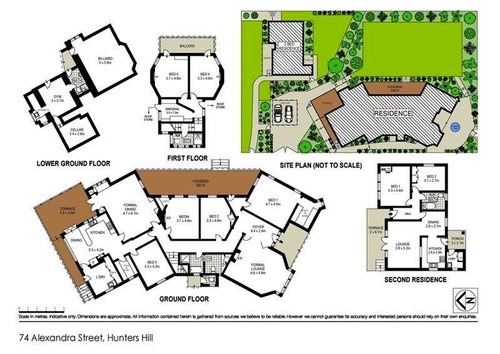 ‘Kurrowah’, a Henry Budden-designed home at 74 Alexandra Street in Hunters HIll came on the market yesterday for the first time in 30 years with a $4.5m ask. At first, it seems like an intimidating price for a home that lacks water frontage and only can stake claim to obstructed water views. The interiors are nothing to write home about (save for an original and unique barrel vault ceiling in the dining room) and the pictures are entirely unimpressive. Weirdly, listing agent Matthew Ward of Ward Partners fails to mention the most important trait this home carries: Henry Budden.
‘Kurrowah’, a Henry Budden-designed home at 74 Alexandra Street in Hunters HIll came on the market yesterday for the first time in 30 years with a $4.5m ask. At first, it seems like an intimidating price for a home that lacks water frontage and only can stake claim to obstructed water views. The interiors are nothing to write home about (save for an original and unique barrel vault ceiling in the dining room) and the pictures are entirely unimpressive. Weirdly, listing agent Matthew Ward of Ward Partners fails to mention the most important trait this home carries: Henry Budden.
"Budden was a prolific architect of public and institutional buildings in early-20th Century Sydney yet only designed a small smattering of residences, making Kurrowah all the more unique. The architect began his practice around the turn of the century and designed the featured home in 1903 (not 1901, as is indicated on the listing). At that time, his asymmetric plan was straight up revolutionary. According to the 1982 Hunters Hill Trust Journal (don’t ask us how we found this):
- "About 1903 Budden designed Kurrowah, the residence of Stephen H. Weedon, 74 Alexarrdra Street. Here his enthusiasm for asymmetry is pronounced, in the broken roof lines and multitude of angles; this is connected with his imaginative use of site. The house was reported and illustrated in the journal of the New South Wales lnstitute of Architects “Mr. Weedon’s house shows clever treqtment of a rather difficult problem in plonning, the building being so orranged that the best rooms command the best views" (Art and Architecture, 2 [1905], 192-94). Today we can see Budden’s radical style if we compare Kurrowah with the Victorian houses opposite, 55 and 57 Alexandra Street, which seem quite conservative by comparison."
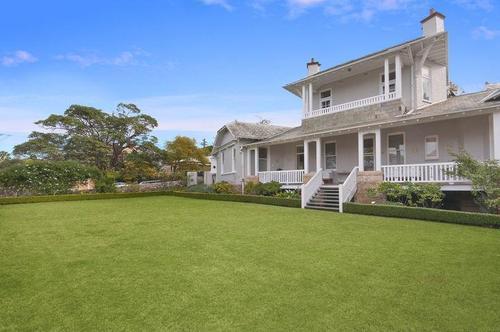
"Budden situated the home to capture northern light and impressive harbour views, views now obstructed by mature trees and recent development. The style of the home merges Craftsman (a style not then commonplace anywhere outside Southern California) and Queen Anne influences and shuns many iconic Federation-style features (ie. red brick exterior, tile roofing) then popular. Budden’s best known designs are likely his Art Deco stylings of the David Jones building in the CBD (1927) and Railway House on York St (1936) also in the CBD.
"If the home does achieve its $4.5m ask, it will be in good company on Alexandra Street. #68 sold for $4.2m in 2008; #84, $4.5m in Sep 2011; #82, $5.09m in May 2005; and #79, $6.5m in Oct 2003. And none of those are waterfront. "
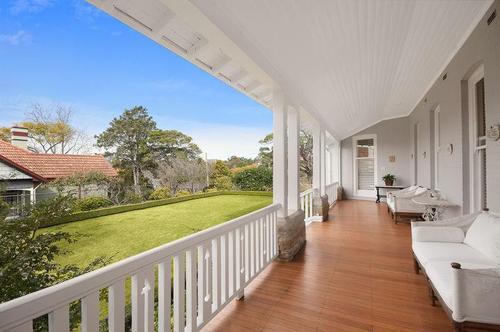
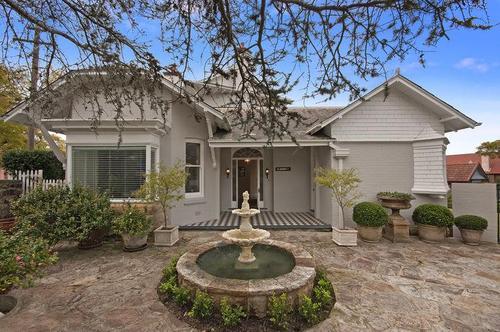
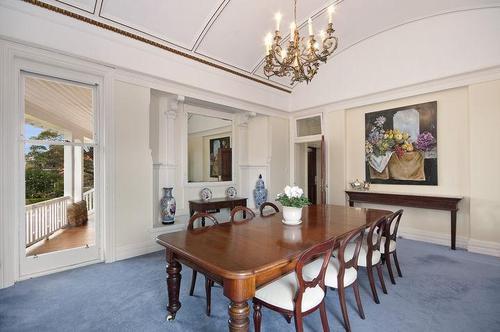
- The listing: Kurrowah, 74 Alexandra Street, Hunters Hill





Mornington (16 Vernon Street)
- See also Mornington, Hunter's Hill

16 Vernon Street looking North from the Street

In 1906 Budden designed Mornington (16 Vernon Street) for Arthur and Ada Muddle (the house derives its name from Mrs. Muddle's fondness for the music of Lord Mornington). This is perhaps Budden's finest house in Hunter's Hill.
 lt shows the tendency of Federation architecture to use a mixture of materials - brick, timber, shingles, rough-cast, slate, terracotta ridging, and sandstone as a rugged base.
lt shows the tendency of Federation architecture to use a mixture of materials - brick, timber, shingles, rough-cast, slate, terracotta ridging, and sandstone as a rugged base.
 lt also shows Budden's prediliction for angular geometric shapes, with many bays and verandahs; the present owners rightly observe that, from above, it resembles a bird with outstretched wings.
lt also shows Budden's prediliction for angular geometric shapes, with many bays and verandahs; the present owners rightly observe that, from above, it resembles a bird with outstretched wings.
||
||
 |
| 16 Vernon Street looking North from the Street |



 |
| 16 Vernon Street Hunters Hill aerial view |

- The house is designed to fullest advantage of the Lane Cove River views and of the movement of the sun around the house through the day. The two unusual little windows at the top were known locally as "the eyes of the river" and were clearly visible from the ferry as it rounded the peninsula towards Mornington Wharf (named after the house, as was Mornington Reserve).
- The interior of the house is well planned but unusual and asymmetrical. Characteristic of the period is the Art Noveau stained glass throughout and the plaster ceiling of the lounge room with its pattern of waratahs and flannel flowers.
- "A classic piece of Hunters Hill and Sydney history. This federation marine villa was designed and built to house the gentry of early Sydney and enjoys a majestic frontage to the Lane Cove River.
Its residents approached the house by ferry along the river to a stone wharf, until roads were paved from Sydney town some years later.
"The second owners, who purchased the home in 1918, were the industrialist Meggiit family, founders of the linseed oil industry in Australia and pioneers of profit sharing in industry.
"The third and current owners of Mornington have painstakingly restored and modernized the residence over the last 10 years and are offering it for lease fully furnished.
"Mornington is one of the finest residences on Sydney Harbour steeped in history and is a statement of class and character for any discerning family seeking to reside in the quiet and exclusive suburb of Hunters Hill." http://www.belleproperty.com/29P0158
The Wurley - 26 Cleveland Street, Wahroonga
Magnificent grand Federation residence built in 1913, designed by noted architect Henry Budden.
 |
| external image 183667_1112036big.jpg |
- Steeped in history and heritage listed
- With sweeping verandahs and magnificent manicured grounds, an abundance of Gosford quarry sandstone defines the setting surrounding the heated swimming pool.
- "The Wurley" is a feature home within the history of Wahroonga.

external image 183667_1112038big.jpg - Positioned on 1,950sqm (approx) of prime East Side land.
- Generous proportions of bedroom and living accommodation.
 |
| external image 183667_1106988big.jpg |
- Classic formal lounge with sandstone fireplace, dining room and separate meals area

external image 183667_1106993big.jpg 
external image 183667_1106999big.jpg - Music room/conservatory overlooking gardens, water feature and grotto
- Separate sunroom leading to covered outdoor alfresco entertaining area

external image 183667_1112041big.jpg - Downstairs family room, newly renovated granite top kitchen with stainless steel appliances and walk in pantry
- Upstairs private children's retreat or further family room

external image 183667_1107002big.jpg - Gymnasium room with sauna, upstairs family spa on private balcony area
- 5 bedrooms , large ensuited master with built in robe, 3 bathrooms in total
- Large covered tiled balcony surrounding bedrooms upstairs

external image 183667_1112048big.jpg
Brand new pool with sandstone paving and sandstone cascading water feature
external image 183667_1112037big.jpg
Does anyone know of other Budden houses?
Career after World War 1
In 1910 Budden moved with his family to Killara. With the outbreak of World War I he began work with the War Chest Commission; he went to Gallipoli and Egypt and became Chief War Chest Commissioner for England and France; he was also awarded the C.B.E. ln 1917 he returned to Australia and resumed his profession of architecture.
His firm operated under the names of Budden & Greenwell (1919-22), Henry E. Budden (1922-31), Budden & Mackey (1931-39), Henry E. Budden (1939-41), and Budden & Nangle (1940-44). The firm of Budden, Nangle, Michael & Hudson is still in business in Sydney and retains the name of Budden for prestige.
In 1931 Budden was elected President of the New South Wales Institute of Architects; this was reported, together with some biographical details, in The Architectural and Building Journal of Queensland, Apr. 10, 1031, 21-23. He was also a Fellow of the Royal British Institute of Architects. He died on December 25th,1944 - "one memorable Christmas day" in the words of his son Philip, one of his seven children.
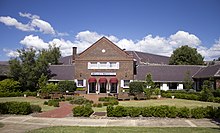  Brassey Hotel (1927) Barton, ACT |   David Jones (1927) Elizabeth Street, Sydney | 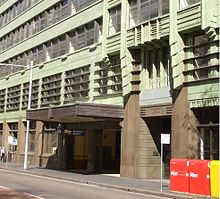  Railway House (1936) York Street, Sydney |










